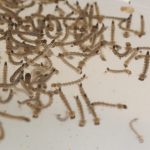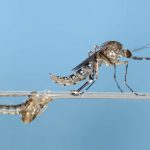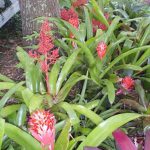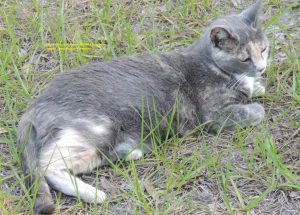From the coast to sandhills, pastures to homestead, dozens of mosquito species are found around Florida homes and neighborhoods. They ease through life in one of four forms – egg, larvae, pupa or adult. As adults, some transmit disease pathogen from infected animals to humans, companion animals, and livestock. Unlocking the life cycle mystery is key to mosquito prevention and protection.
Life Cycle.
Mosquito species requiring permanent water, lay eggs directly on water surface. Florida’s St. Louis encephalitis mosquito prefers to lay in permanent water.

Floodwater type mosquitoes lay eggs in moist substrate such as leaf litter. They also lay eggs at high tide or where flooding occurred. Floodwater eggs require a drying out period to become viable and hatch the next time they are covered with water. Both floodwater and permanent water larvae live in water.
Larvae, also called ‘wrigglers’ or ‘wigglers’ are the easiest life stage to control. The greatest impacts on mosquito populations occur at this life stage. They are susceptible to cultural, chemical, and biological controls. If larvae survive predation by frogs, native fish species and dragonfly nymph, 
Adult female salt marsh leaves the cast-off pupal skin underwater.life gets interesting at the pupa stage. Pupa lack functioning mouth parts. By design, pupa do not eat or poop. They survive on stored energy reserve.
Pupal skin is shed as adults emerge. Once airborne, male and female mosquito feed on nectar, plant fluids and sugar feeding insects. The male is essential for reproduction. However, the female requires bloodmeal for egg development. Her tube-like mouthpart, the proboscis, pierces host skin and extracts blood. Female can ‘bite’ more than once. On average, females live three to six weeks, but can live up to five months.

No Water, No Larvae.
Routinely drain saucers under potted plants. Cupped plants such as, bromeliad (Weaver et al, 2021), pitcher plants and water lettuce could support egg, larvae and pupa stage. Clear out thick brush to increase air-flow around the house.
Empty and scrub outdoor pet bowls and wading pools 2-3 times per week during summer. Dump bird bath water once a week. Keep floating debris out of ponds and vegetation short surrounding ponds. Maintain free-flowing ditches and culverts.
“Government has utilized modern pesticides, after weighing cost and benefit in the interest of public safety and human health.” D.A. Drew, Commercial Agriculture Agent (ret.), UF/IFAS Extension Levy County
Chemical control.
Household chemicals such as “dunks” contain bacteria, Bacillus thuringiensis israelensis (Bti). Bti specifically targets larvae and may be one method of larvae control. Granules are available as are household premises sprays.
Levy County Mosquito Control District works to reduce adult mosquito populations with aerosol chemicals. PERMXUL 4-4 sticks to their wings and prevents flying. Bee hives should be registered with Florida Department of Agriculture and Consumer Services. Contact Levy County Mosquito control 352-486-5127 to be placed on the no-spray list.
BVA oil controls larvae and pupa.
Around the Home.

Keep flying adults out of the home. Repair cracks, open vents and screens on windows and doors. Protect skin with long sleeve shirt and pants. Registered repellents are approved for human use. Follow label instructions.
More tips on personal repellants (Rutledge and Day, 2019) and mosquito proofing the home may be found at FloridaHealth.gov. Florida Department of Health (DOH) lists Eastern equine encephalitis (EEEV) disease, Chikungunya, dengue, and West Nile fever as mosquito transmitted viruses.
“ Mosquito-borne viruses rarely cause illness in dogs and cats, but mosquitoes can transmit heartworms to dogs and cats, which can cause a fatal disease. It is recommended for dogs and outside cats to be on a heartworm preventative that can be given on its own or in a flea, tick, and heartworm combo prevention medication. “ Eva Buckner, Ph.D., Assistant Professor & State Extension Specialist, UF/IFAS Florida Medical Entomology Laboratory

An organ at the wing base strums against the wings creating the signature buzzing. The buzz is a mosquito mating call and prompts me to stow garden tools and head inside. Until next time – Happy Gardening!
Resources.
University of Florida’s Medical Entomology Laboratory web site.
A color, 3”x4” mosquito ID deck is available at the IFAS bookstore , search mosquito.
C. Roxanne Connelly, 2019, UF publication, Hurricanes and Mosquitoes
C. Roxanne Rutledge and Jonathan F. Day, 2019, Mosquito Repellents
Ana L. Romero-Weaver, L. Philip Lounibos, and Eva A. Buckner, 2021, Mosquitoes and Bromeliads
Source: UF/IFAS Pest Alert



